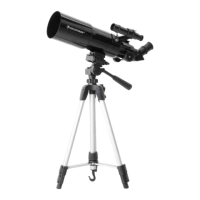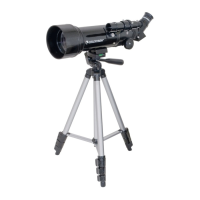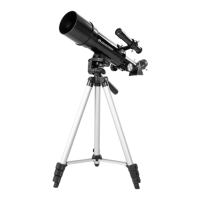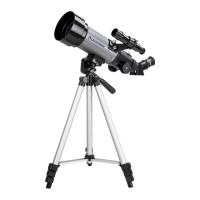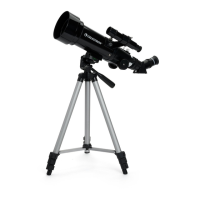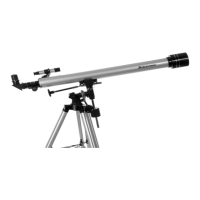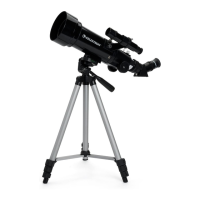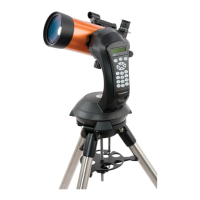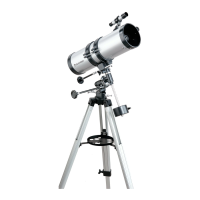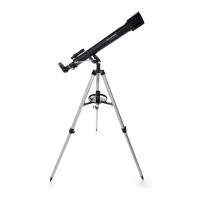Do you have a question about the Celestron Travel Scope 50 and is the answer not in the manual?
Instructions for extending and adjusting the tripod legs for desired height.
Steps to securely mount the telescope optical tube onto the tripod mounting platform.
How to control telescope movement using altitude and azimuth locking knobs.
Guide to attaching the diagonal and inserting an eyepiece for viewing.
Instructions for attaching the finderscope bracket to the telescope tube.
Procedure to align the finderscope with the main telescope for easier object acquisition.
How to use the focus knob to achieve a sharp image of the observed object.
Formula and explanation for determining telescope magnification based on eyepieces.
Guide on how to attach and use the Barlow lens to increase magnification.
Method to calculate the actual field of view of the telescope and eyepiece combination.
Advice on best practices for optimal viewing and image quality.
Explanation of the celestial coordinate system used for locating objects in the sky.
Description of how stars appear to move in the sky due to Earth's rotation.
Tips and best practices for observing the Moon, including optimal phases and filters.
Guidance on observing planets, noting details visible and atmospheric condition influences.
Crucial safety precautions and methods for observing the Sun.
Information on viewing objects beyond the solar system and factors affecting visibility.
Method for locating celestial objects by navigating between known stars.
Factors affecting atmospheric clarity, such as clouds, moisture, and aerosols.
Impact of light sources like the Moon and light pollution on observing.
Atmospheric stability's effect on image detail and sharpness.
Detailed instructions on how to properly clean the telescope's optical components.
Instructions for extending and adjusting the tripod legs for desired height.
Steps to securely mount the telescope optical tube onto the tripod mounting platform.
How to control telescope movement using altitude and azimuth locking knobs.
Guide to attaching the diagonal and inserting an eyepiece for viewing.
Instructions for attaching the finderscope bracket to the telescope tube.
Procedure to align the finderscope with the main telescope for easier object acquisition.
How to use the focus knob to achieve a sharp image of the observed object.
Formula and explanation for determining telescope magnification based on eyepieces.
Guide on how to attach and use the Barlow lens to increase magnification.
Method to calculate the actual field of view of the telescope and eyepiece combination.
Advice on best practices for optimal viewing and image quality.
Explanation of the celestial coordinate system used for locating objects in the sky.
Description of how stars appear to move in the sky due to Earth's rotation.
Tips and best practices for observing the Moon, including optimal phases and filters.
Guidance on observing planets, noting details visible and atmospheric condition influences.
Crucial safety precautions and methods for observing the Sun.
Information on viewing objects beyond the solar system and factors affecting visibility.
Method for locating celestial objects by navigating between known stars.
Factors affecting atmospheric clarity, such as clouds, moisture, and aerosols.
Impact of light sources like the Moon and light pollution on observing.
Atmospheric stability's effect on image detail and sharpness.
Detailed instructions on how to properly clean the telescope's optical components.
| Type | Reflector |
|---|---|
| Lens diameter | 304.8 mm |
| Magnification | 120 x |
| Fixed focal length | 20 mm |
| Visual power (max) | 51 x |
| Product color | Black |
| Bundled software | Celestron's Starry Night Basic Edition Software, SkyPortal App |
| Carrying case | Yes |
| Weight | 680 g |
|---|

